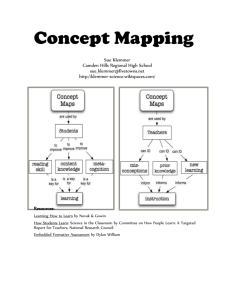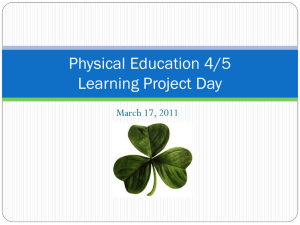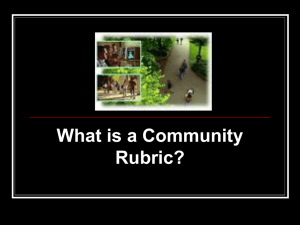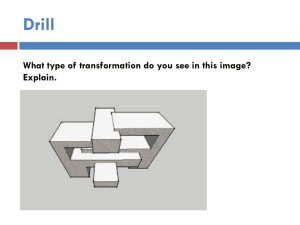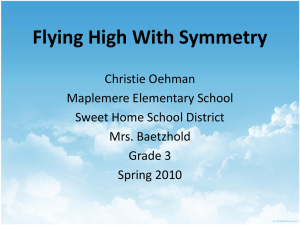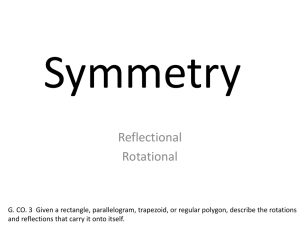Concept Mapping Presentation
advertisement
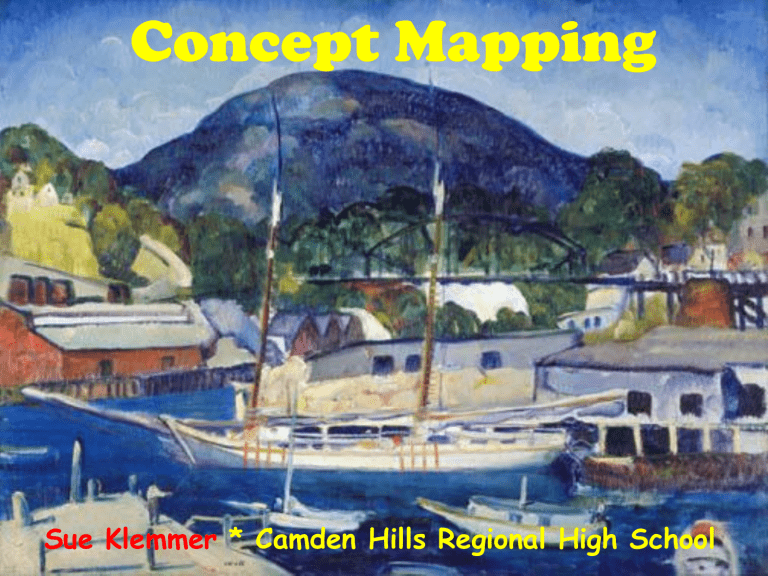
Concept Mapping Sue Klemmer * Camden Hills Regional High School “Corners” Introduction THINK: What do you want to get out of Please go to the this workshop? poster that most WRITE your goal(s) on the poster. closely matches SHARE your goals with one another. your experience What do you notice? with concept PICK a spokesperson to share your mapping. goals with the rest of the group. Norm s • minimize side talk • get up whenever! • ask questions any time ... and? In the next 2 hours ... what’s a concept map? • make a basic map & discuss • compare map technologies what’s a map do? • different uses for maps • grading vs. feedback; rubrics • a look at student work mapping power • hierarchy & symmetry • make a 2nd map & peer edit What’s a Concept Map? concept maps show relationships between ideas, rather than definitions maps are visual tools that organize knowledge maps must have: 1. concepts: ideas in bubbles; nouns 2. links: labeled lines; verbs 3. these connect as “concept-link-concept” sentences concept maps contain concepts contain express relationships links Map Technologies a good technology is easily edited & easily shared 1. 2. 3. 4. 5. paper & pencil whiteboards /benchtops sticky notes & string or chalk word processors software • • “Inspirations” “Omnigraffle” ME-MLTI Task: Make a Map 1. Divide team into pairs. 2. maps with your • Swap Put each term onpartner. a 3. Have one partner read out loud separate sticky note. Do each “concept-link-concept”. make grammatical sense? • they Think about how they Edit if needed. are related. 4. Repeat for the other partner. 5. your maps. Whaton do • Compare Move them around you notice? a piece of paper and 6. Put the pairs together as a 4. with 7. lightly Have eachconnect person share something lines. they noticed about his/her partner’s map. •8. Like it?what Mark in the Discuss: insights do we want share with the larger linestoand label them. group? instructional practice professional development student learning Early Maps keep first efforts small and structured 1. “Make a map from these 3 words: ___” 2. “Make a map from these 3 words (___) plus two more concepts of your own from your reading ___.” 3. “Make a map of 4-5 key words from reading ___.” Early Maps: “Buy In” keep first efforts enjoyable and useful low stakes or no stakes grading opportunities to share and edit USE THEM! avoid “mapping for mapping sake”; what’s the purpose? • probe prior knowledge • get main ideas from a reading • pull different lessons together for review Simple Map Rubric All required concepts are present. Required concepts represent important ideas. All concepts are connected to another concept. All links are labeled. All links make grammatical sense & scientific sense. Typical Error #1: Definitions Typical Error #1: Definitions is Typical Error #2: Dependency Walk & Talk • Get up and walk about! Stretch! • STOP and share one new thing you’ve learned. Task: Student Work • Get the “Basic Map Rubric” page in your packet. • Evaluate each sample map. • Write 4 sticky note feedback comments for each student: TEAM WORK: 1. In a “roundrobin” report out your scores for the first sample. Come to consensus! 2. Share your feedback for this student. Select the 2-3 you think most helpful to the student. 3. Repeat for the 2nd sample. 4. Be prepared to share o “warm” & “cool” an “ahah!” or a o on science & on the map “hmm?” Hierarchy & Symmetry HIERARCHY requires students to prioritize the importance of ideas. SYMMETRY requires students to “chunk” knowledge into parallel pieces. This builds “HOTS”. Some students will do this intuitively, but it should not be pushed until basic skills are mastered. Hierarchy & Symmetry the topic main idea #1 detail detail main idea #2 detail “lead to” idea main idea #3 detail detail Unusual Hierarchy! a more advanced rubric All required concepts are present. All concepts are connected to at least one other concept. Multiple links highlight a few significant crossconnections. All links are labeled and substantial. All links make grammatical sense & scientific sense. The map uses one of the following strategies: • hierarchy to show the relative importance of different concepts. • symetry to show “chunking” of ideas into groups. Task: Make a Map #2 • As a team, select a topic in chemistry you would be interested in having students map. • Brainstorm a list of key concepts. Select 3-4 concepts all maps must have. • Make a map of 6-10 concepts on your own, using your choice of “basic” or “advanced” rubric. Editing: 1. Swap maps with a partner. Tell him/her what rubric to use. 2. Evaluate your partner’s map using the correct rubric. 3. Provide “warm” and “cool” feedback on his/her mapmaking. 4. Get your own map back. Edit it. 5. Time permitting, swap with another member of the team. Survey says ... 68% 58% Using Maps: a Review Resources
